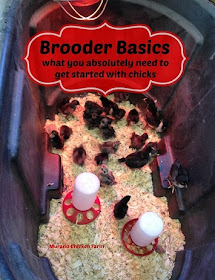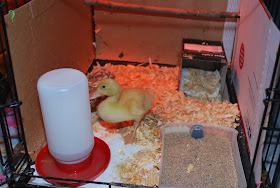From heat source to feed, all of the item's you'll need can be bought at any feed store so picking up everything you need should be quite simple!
How do I set up a chick brooder?
What is a brooder: A brooder is any type of escape proof container to house chicks in until they have grown enough to be moved into their chicken coop. It will include a heat source, bedding, food and water.Brooder box
First you need a container. A big box will do or you can use a plastic Tupperware type container, a feed tub, stock tank, aquarium, a baby pool etc. Anything the chicks can't get out of. If you're brooding ducks you'll probably be better off going with plastic as you'll spend a whole lot more time cleaning up wet litter.You can get large boxes from the grocery store or save one next time you get something big in the mail or from the store. I get crate style boxes free from the farm equipment dealer. I've also used large bird cages, or guinea pig cages...even small dog crates.
Dog crates might need to be lined with cardboard at first until the chicks are too big to fit through the bars. See picture below.
Brooder heat source.
You have many different choices in brooder heat sources. Cheapest to buy is a heat lamp. Safest is a Brinsea Ecoglow, but it is a little more expensive than a heat lamp. However, if you are planning on brooding chicks several times or every year....then the Ecoglow will actually save you money in the long run as it costs less per day to run then a heat lamp.If you decide to use a heat lamp, you'll want to get a red heat bulb to discourage pecking. You'll also want to secure it. Never EVER trust just the clamp on a heat lamp!!!! We zip tie them to a hook in the wall, a table leg...anything secure. Safety first! A heat lamp touching a cardboard box or bedding can catch fire!
When using a heat bulb, we prefer the ceramic heat bulbs. More expensive, but definitely safer. (sold in the reptile dept of the pet store or online, Amazon has them)
Whatever you choose you'll want it to be 95°F at bedding level for the first week. Use a thermometer to check and make sure the chicks have enough room to get away from the heat if they get too warm.
Brooder bedding.
We buy pine shavings by the bag from Tractor Supply Center. Use pine, NOT ceder. Some people prefer hay, straw, recycled paper pellets, a layer of paper towels etc. We prefer the pine shavings. They run about $5 a bag and 1 bag will last you over a month for a average sized chick brooder.Do not use flat newspaper in the brooder as the chicks feet will not be able to grip on it and their legs will splay out underneath them causing spraddle leg.
Chick feed and water containers.
Preferably tip proof and not very deep. These guys are little after all. You wouldn't want them to get into a deep water bowl and drown! I bought the special chick sized ones for the first few weeks. I also buy dollar store cat food bowls that work just fine for chicks. (and are much cheaper)Over the years we've used everything from jar lids to microwave containers though. As long as their clean and shallow they should do the job.
Of course you'll need feed and clean water but were just talking equipment here. Now let's talk expense....you can do the whole deal for under $15 bucks on a budget or $200 if you're my husband. Ready to hear this one?
You're looking at a 10 gallon aquarium, reptile heat lamp, 2 small red heat bulbs and a mesh tank topper. What you can't see is a reptile heat pad attached to the underside of the tank. No kidding, over $200...however, it does look nice inside the house (although they outgrow it quick and chick dust is now in the house! *sigh*)
Expense aside you will need to plan for growth. Many people like to use different sized boxes as the chicks grow, or move them to a larger cage when they get to be a few weeks old. Once they can fly you'll need to reevaluate their brooder. You wouldn't want them flying out and not being able to get back in!
Heat and feed needs differ as they grow, but that's another post entirely...find it here at How to raise chicks. I hope this has helped you figure out exactly what you need to bring chicks home and start you chicken keeping adventure!
~Lisa
Want information on raising chickens sent right to your email weekly? Click right here to join my list and get new posts sent directly to you the day they're published. You'll also get the free download 25 Ways to save money raising chickens.
This post contains affiliate links. If you chose to purchase something through the link, I will get a small payment from Amazon. It will not affect your purchase price. Click for full disclosure.









Great information, especially thinking about making a bigger area for your chicks. The first time I got chicks, I sorta didn't really think much about them growing SUPER DUPER fast. I needed a bigger place pretty quick! Thank goodness my Dad is great at building things.
ReplyDeleteThey do grow quickly don't they? Always great to have a builder around....although I think my husband is sick of me constantly needing new stuff built. LOL
Delete~L
We just got our first bunch of chickens this spring. And they grew fast. they are out in the coop now and love it.! I just found your blogl, and I LOVE it! Thanks for all the great advice!!
ReplyDeleteIt's awesome when you can finally get them into their own coop! No more chick dust in the house. lol I'm glad you like the blog, if there's anything you'd like to read about, just let me know!
Delete~L
Great resource for beginners. I got older chicks, but would like to hatch some out or get day old chicks when available. Only problem is I don't have a basement or enclosed porch so inside the house would be my only option and I don't want it smelling like chickens or full of chicken dust :-( Guess I have to keep working on that idea.
ReplyDeleteYoung chicks are pretty dusty, but if you change the litter every few days they don't smell too bad. Good luck!
Delete~L
what about getting guinea fowl hatching eggs and putting them under a broody hen? Hens will brood pretty much any eggs, fertilised or not! and it's all so much easier than incubators, heat lamps, broody boxes and cheaper too!
ReplyDelete